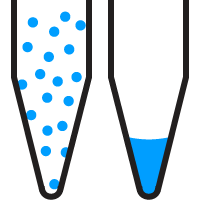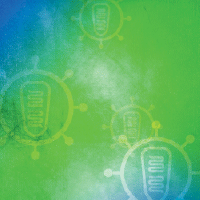Fourth-generation lentiviral packaging overview
Lenti-X fourth-generation packaging systems are optimized for viral yield, ease of use, and safety. Use these systems to produce ultra-high titers of lentivirus. There are two pseudotype (envelope protein) options to choose from, depending on your desired tropism:
- VSV-G lentiviral packaging—produces VSV-G pseudotyped lentivirus, which readily infects virtually all types of cells. A nonintegrating version is also available.
- Ecotropic lentiviral packaging—produces lentivirus pseudotyped with the MLV ecotropic envelope glycoprotein, which limits transduction to mouse and rat cells.
Watch the video to find out how our fourth-generation packaging system can generate such high titers.
 High lentiviral titer
High lentiviral titer
Our Lenti-X packaging systems generate lentiviral titers that far exceed most other commercially available packaging systems—you can expect titers of 107–108 infectious units (IFU) per ml, 25 times what other popular systems generate.
How are such high titers achieved?
- Optimized composition—Lentiviral packaging and nonviral components are provided as a proprietary suite of five vectors (Figure 1), premixed in the ideal ratio to maximize virus production
- Tetracycline transactivation—High-level expression of packaging components using Tet-system promoters
- Optimized transfection—Xfect Transfection Reagent consistently results in >95% transduction efficiency for HEK 293T cells, allowing high expression of packaging components
- Specialized Lenti-X 293T cell line—Highly transfectable cells selected to provide titers as high as 108 IFU/ml

Figure 1. Takara Bio's Lenti-X HTX Packaging Systems consist of five separate vectors (left). High expression of essential viral components are driven by the Tet-Off and Tat transactivators. The pol gene is fused to vpr to ensure transport of the reverse transcriptase/integrase protein into the recombinant viral particle. Other, third-generation systems (right) do not contain separate gag and pol sequences. Not all vector elements are shown.
How much packaged lentivirus can be obtained from a single Lenti-X packaging reaction?
A single Lenti-X HTX packaging reaction (now replaced by Lenti-X Single Shots) generates 10 ml of unconcentrated lentiviral supernatant at 107–108 IFU/ml. Leading competitor systems produce far less (Figure 2).

Figure 2. Lenti-X (Panel A) and a competitor's packaging system (Panel B) were each used with Lenti-X 293T cells to generate lentiviral vectors that express ZsGreen1. The supernatant was used for transduction of HeLa cells. 10 µl of the Lenti-X packaging reaction was able to transduce the majority of the cells, whereas 10 µl of the competitor's supernatant transduced only a small percentage of cells.
The maximum titer obtained by our scientists is ~5 x 108 IFU/ml (unconcentrated supernatant), as determined by analysis of ZsGreen1 expression from a pLVX backbone by flow cytometry. The cPPT/CTS, RRE, and WPRE sequences and the wild-type 5' LTRs on pLVX vectors contribute to higher titers. In 13 independent packaging reactions performed with 10 different fluorescent protein constructs, the average titer obtained for pLVX vectors packaged using the Lenti-X system was 1.85 x 108 IFU/ml, as determined by flow cytometric analysis of transduced HeLa cells.
 Lentiviral packaging FAQs
Lentiviral packaging FAQs
Watch a video and see how easy it is to use Lenti-X Packaging Single Shots to obtain consistently high lentiviral titers.
What type of cells should be used for packaging?
Lenti-X Packaging Single Shots (VSV-G) provide an extremely simple and consistent one-step method for producing high-titer VSV-G pseudotyped lentivirus. The single-tube format consists of individual vials containing lyophilized Xfect Transfection Reagent premixed with an optimized formulation of Lenti-X lentiviral packaging plasmids. High-titer virus is produced by simply reconstituting this mixture with your lentiviral vector of choice in sterile water and adding it to 293T cells in a 10-cm dish.

Figure 3. Lenti-X packaging workflow.
In addition to Lenti-X Packaging Single Shots, we also offer packaging systems for generating VSV-G pseudotyped lentivirus and ecotropic pseudotyped lentivirus in a traditional format. These kits include packaging mix and Xfect Transfection Reagent as separate liquid components.
Lenti-X packaging systems are optimized for use with Lenti-X 293T Cells, a clone selected at Takara Bio for its ability to generate high-titer lentivirus. HEK 293 and 293FT cells can be used but will produce lower titers of packaged lentiviral particles (Section: High lentiviral titer; Figure 2).

Figure 4. Lenti-X 293T cells produce over six times more virus than 293FT cells, and up to 30 times more virus than HEK 293 cells.
How consistent are results?
Eliminating variability during reaction setup leads to consistent transfections that consistently yield high viral titers.

Figure 5. Consistent, high-efficiency transfections lead to high titers. A lentiviral vector encoding ZsGreen1 was packaged according to the Lenti-X Single Shots protocol in four independent experiments. Forty-eight hours after transfection, the cells were imaged by fluorescence microscopy (Panel A, top) and light microscopy (Panel A, bottom). After images were taken, the supernatant was harvested and used to infect HT1080 cells for titer determination (Panel B, IFU/ml).
Which types of lentiviral vectors are compatible with this system?
We have not tested all vectors, but in principle, any HIV-1-based vector should be efficiently packaged using this system, resulting in high-titer lentivirus. For example, a ZsGreen1 cassette in the pLenti6/V5 vector (Thermo Fisher Scientific)—a vector that lacks the WPRE and cPPT/CTS sequence elements and utilizes self-inactivating (SIN) LTRs—yielded titers of >3 x 107 IFU/ml, as determined by flow cytometry. Since the Lenti-X system utilizes Tat transactivation, lentiviral vectors that utilize HIV-1 5' LTRs (such as pLVX vectors) will generate higher titers than those containing other LTRs. Vectors lacking WPRE and/or cPPT/CTS sequences yield consistently lower titers than Takara Bio pLVX vectors.
Note: Use of vector systems other than Takara Bio's may require additional rights from third parties. You should evaluate whether permission from any third party is required for your intended use.
Lenti-X Packaging Single Shots can produce high-titer virus regardless of the lentiviral vector backbone used and regardless of the method used for titration.

Figure 6. High-titer virus is produced regardless of the lentiviral vector backbone. A CMV ZsGreen1 expression cassette was cloned into several lentiviral vector backbones. These vectors were then packaged into lentivirus using Lenti-X Packaging Single Shots following the provided protocol. After 48 hr, titer was determine using several methods. To determine infectivity, the supernatant was harvested and used to infect HT1080 cells (flow cytometry). Harvested viral supernatants were also analyzed by RT-PCR to quantify viral genome copies (qRT-PCR, Lenti-X qRT-PCR Titration Kit), by ELISA to measure p24 (p24 ELISA, Lenti-X p24 Rapid Titer Kit), and by a rapid lentiviral-detection method (Lenti-X GoStix).
What is the cloning/packaging capacity of an HIV-1-based lentiviral vector?
Wild type lentiviruses contain ~9.7 kb of genome including both LTRs. Artificially creating a genome larger than this will result in unstable viral particles and a dramatic drop in viral titer. For recombinant lentiviruses such as those generated using Lenti-X systems, much of the viral genome has been replaced with other useful sequences such as selection markers or fluorescent proteins, but enough space remains for cloning transgenes.
- The 3' LTR of pLVX-Puro ends at 5.4 kb, so ~4.3 kb of space remains for you to clone in your gene
- The 3' LTR of pLVX-IRES-tdTomato ends at 6.3 kb, so ~3.4 kb of space remains for you to clone in your gene
 Improved safety profile
Improved safety profile
Although all lentiviral vectors should be handled in at least a BSL-2 laboratory, biosafety issues can be greatly mitigated by carefully considering the nature of the transgene insert and by ensuring that viral replication is restricted to specific packaging cells that provide these essential functions, in trans. For lentiviral transfer vectors to generate DNA-mobilizing, replication-competent lentivirus (RCL), several additional viral sequences must be acquired from the packaging plasmids via recombination (i.e., the structural genes gag-pro and env; and the reverse transcriptase/integrase gene, pol). In third-generation systems, gag-pro and pol sequences are in the same transcriptional unit, while env (VSV-G) is on a separate plasmid. Therefore, in these systems, generation of RCL requires two recombination events. With Lenti-X Packaging Systems, gag-pro and pol are further separated onto two plasmids (Figure 7), such that three low-frequency recombination events would be needed to generate RCL. Click here for more safety information.

Figure 7. Takara Bio's Lenti-X HTX Packaging Systems consist of five separate vectors (left). High expression of essential viral components are driven by the Tet-Off and Tat transactivators. The pol gene is fused to vpr to ensure transport of the reverse transcriptase/integrase protein into the recombinant viral particle. Other third-generation systems (right) do not contain separate gag and pol sequences. Not all vector elements are shown.
 Available products for lentiviral packaging
Available products for lentiviral packaging
| Product name | Features | |
|---|---|---|
| Lenti-X Packaging Single Shots | Extremely simple and consistent one-step method for producing high-titer-generating VSV-G pseudotyped lentivirus | Learn more » |
| Lenti-X 293T Cell Line | 293T clone selected for high-titer lentivirus production | Learn more » |
Takara Bio USA, Inc.
United States/Canada: +1.800.662.2566 • Asia Pacific: +1.650.919.7300 • Europe: +33.(0)1.3904.6880 • Japan: +81.(0)77.565.6999
FOR RESEARCH USE ONLY. NOT FOR USE IN DIAGNOSTIC PROCEDURES. © 2025 Takara Bio Inc. All Rights Reserved. All trademarks are the property of Takara Bio Inc. or its affiliate(s) in the U.S. and/or other countries or their respective owners. Certain trademarks may not be registered in all jurisdictions. Additional product, intellectual property, and restricted use information is available at takarabio.com.




